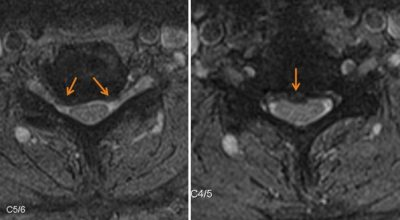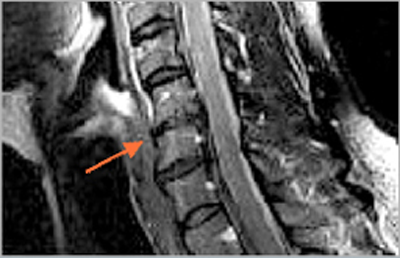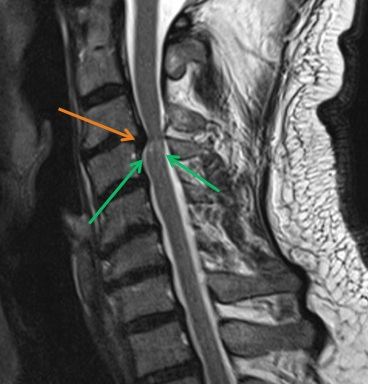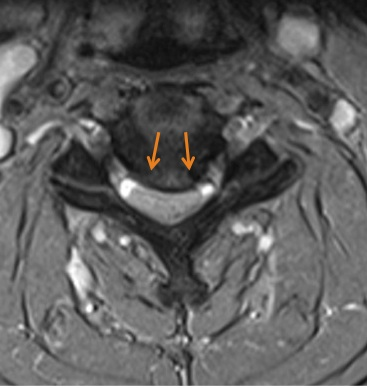Disc herniation
About 20% of all disc herniations occur in the cervical spine. Mostly a sudden sharp pain similar to sciatic pain in the arm occurs. Patients may experience pins and needles, numbness or even a loss of strength. The source of complaints is the pressure upon the nerve root exercised by disc material. Big and medially situated herniations may be dangerous to the spinal cord itself. Here operative therapy is urgently required. Disc herniations in the cervical spine tend to ossify quickly thus causing the so called “hard disc” which may compromise the width of the spinal canal when situated medially or the nerve channels (foramina) when situated laterally. In many cases there will be a need for operative decompression.

MRI of the cervical spine demonstrating a large disc herniation (arrow)
Narrowing of the neuroforamina ” foraminal stenosis”
Narrowing of he nerve channels is seen in many patients harbouring severe degeneration of the cervical spine, mostly in several segments. Bony impingement of the nerve far laterally in the channel leads to typical symptoms e.g. radiating pain, numbness. Sometimes a weakness appears, too. The combination of disc herniation and bony stenosis is frequent.

Computed tomography,
demonstrating a bony foraminal stenosis predominantly on the right side (arrows)
Stenosis in the cervical spine and disc degeneration
As mentioned above, bony spurs are a frequent sign of degeneration of the discs.
Nature tries to stabilise and fuse the degenerated segment but this can lead to impingement either of the spinal cord or the nerve channels. In most cases operative decompression is inevitable to protect the spinal cord or the nerve root from further damage caused by pressure.
Degeneration of cervical disc C4/5 and 5/6 with impingement of the spinal cord


MRI demonstrating disc degeneration at C5/6 level (arrow)

Cervical myelopathy
This is a chronic pressure lesion of the spinal cord itself and leads to gait disturbances, weakness in the arms and hands and even the legs and can lead to a paralysis. If symptoms of a cervical myelopathy are caused by an impingement, only operative decompression can stop progression or lead to an improvement of the symptoms.
Cervical myelopathy (green arrow) due to disc herniation (red arrow)




